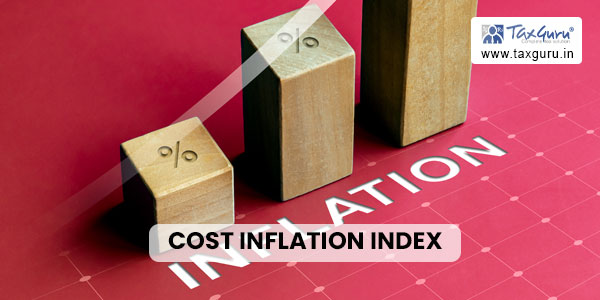COST INFLATION INDEX in India:
Cost Inflation Index (CII) is an index used in India to measure the rate of inflation in the economy. It is used to adjust the purchase price of an asset, such as property or gold, for inflation when calculating capital gains tax.
The Central Board of Direct Taxes (CBDT) publishes the CII every year. The base year for the index is 2001-02, and the CII for the base year is 100. The index value for subsequent years reflects the cumulative inflation rate since the base year.
When an asset is sold, the capital gain is calculated as the difference between the sale price and the cost of acquisition. However, since inflation erodes the value of money over time, the cost of acquisition must be adjusted for inflation to arrive at the real cost of acquisition. This is where the CII comes into play. By using the CII to adjust the cost of acquisition, the capital gains tax liability can be calculated more accurately.
For example, if an asset was acquired in 2005 for Rs. 10 lakh and sold in 2022 for Rs. 30 lakh, the actual gain is not Rs. 20 lakh, but the gain after adjusting for inflation using the CII for the relevant years. The CII for 2005-06 was 117, and for 2022-23, it is 317. The indexed cost of acquisition would be Rs. 26,495, and the capital gain would be Rs. 3,50,505.
(A) Transactions where we can use COST Inflation Index ?
The Cost Inflation Index (CII) is used in India to calculate the capital gains tax liability on the sale of assets. The following types of transactions typically use the CII:
1. Sale of Property: When a property is sold, the capital gains tax liability is calculated based on the difference between the sale price and the indexed cost of acquisition. The indexed cost of acquisition is calculated by applying the CII to the original cost of acquisition.
2. Sale of Shares/Mutual Funds: Capital gains tax on the sale of shares or mutual funds held for more than one year is calculated based on the indexed cost of acquisition. The indexed cost of acquisition is calculated by applying the CII to the original cost of acquisition.
3. Sale of Gold: Capital gains tax on the sale of gold held for more than three years is calculated based on the indexed cost of acquisition. The indexed cost of acquisition is calculated by applying the CII to the original cost of acquisition.
In summary, the CII is used to adjust the cost of acquisition of assets for inflation, to arrive at the indexed cost of acquisition. This is used to calculate the capital gains tax liability on the sale of assets.

(B) Transactions not covered under COST Inflation Index:
The Cost Inflation Index (CII) in India is primarily used for the calculation of capital gains tax liability on the sale of certain assets. However, there are certain types of transactions that are not covered under the CII. These include:
1. Short-term capital gains: The CII is not applicable for assets held for less than the specified period, such as shares, mutual funds, and property held for less than one year. Short-term capital gains tax on such assets is calculated based on the actual cost of acquisition and sale price.
2. Inherited assets: The CII is not applicable for assets that are inherited. The cost of acquisition for inherited assets is considered to be the cost of acquisition of the original owner.
3. Agricultural land: The CII is not applicable for agricultural land in India, as it is exempt from capital gains tax. However, if the agricultural land is converted into a non-agricultural use, such as residential or commercial use, the capital gains tax liability arises and the CII is used to calculate the indexed cost of acquisition.
4. Business assets: The CII is not applicable for assets used in business or profession, such as machinery, plant, and equipment. The cost of acquisition of such assets is considered to be the actual cost of acquisition.
In summary, the CII is not applicable for short-term capital gains, inherited assets, agricultural land, and business assets. The capital gains tax liability for such assets is calculated based on the actual cost of acquisition and sale price.
NOTIFIED COST INFLATION INDEX UNDER SECTION 48, EXPLANATION (V)
Cost inflation index for the Financial Year 2023-24 is 348. The CBDT notified this on 10 April 2023 vide Notification No. 21/2023.
As per Notification no. 62/2022, dated 14-06-2022 following table should be used for the Cost Inflation Index :-
| Sl. No. | Financial Year | Cost Inflation Index |
| (1) | (2) | (3) |
| 1 | 2001-02 | 100 |
| 2 | 2002-03 | 105 |
| 3 | 2003-04 | 109 |
| 4 | 2004-05 | 113 |
| 5 | 2005-06 | 117 |
| 6 | 2006-07 | 122 |
| 7 | 2007-08 | 129 |
| 8 | 2008-09 | 137 |
| 9 | 2009-10 | 148 |
| 10 | 2010-11 | 167 |
| 11 | 2011-12 | 184 |
| 12 | 2012-13 | 200 |
| 13 | 2013-14 | 220 |
| 14 | 2014-15 | 240 |
| 15 | 2015-16 | 254 |
| 16 | 2016-17 | 264 |
| 17 | 2017-18 | 272 |
| 18 | 2018-19 | 280 |
| 19 | 2019-20 | 289 |
| 20 | 2020-21 | 301 |
| 21 | 2021-22 | 317 |
| 22 | 2022-23 | 331 |






I need CII for Industrial Machinery